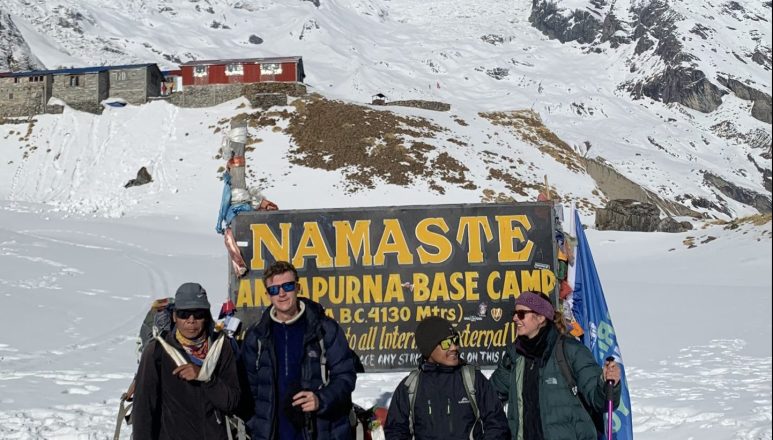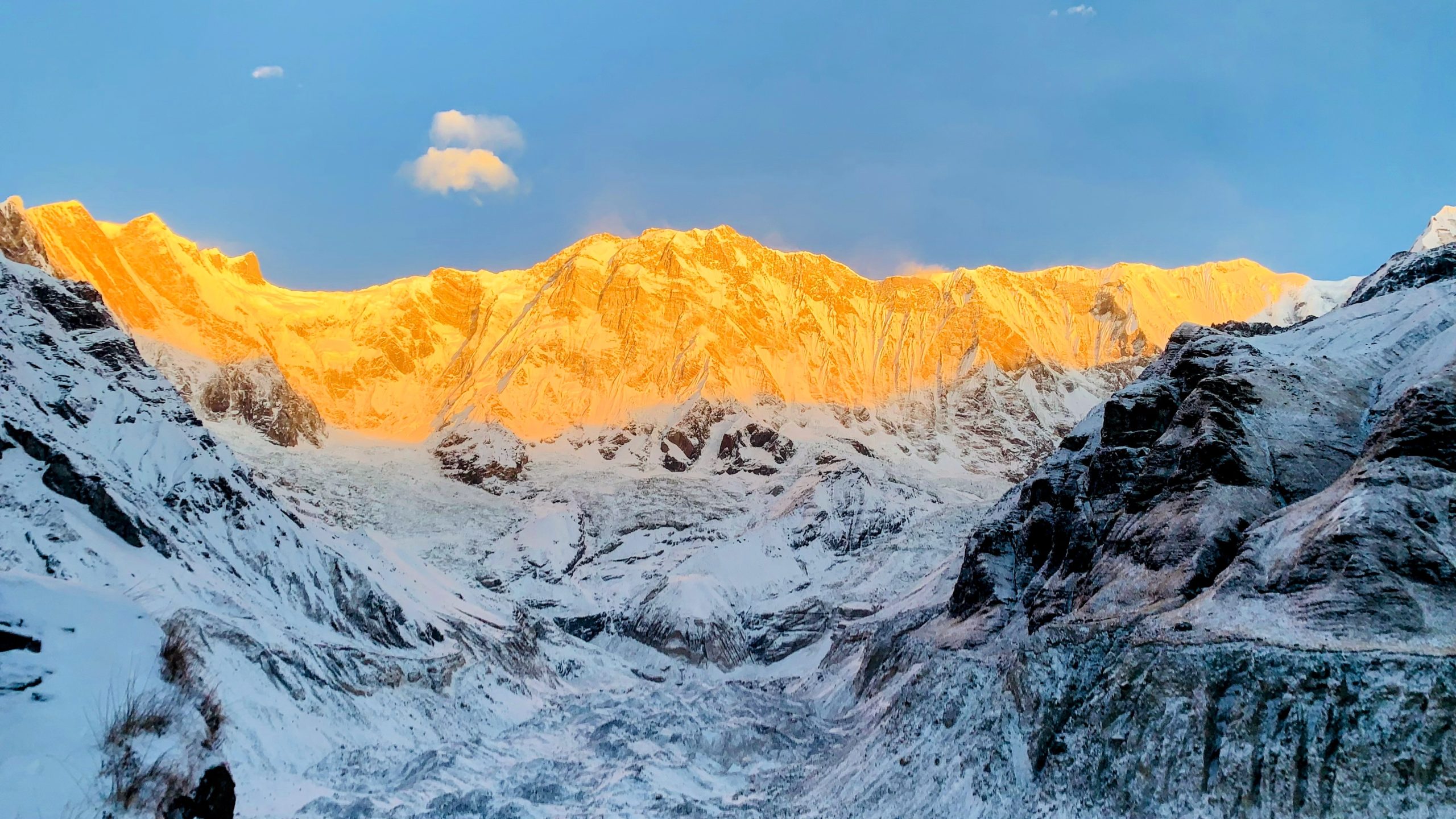Annapurna Base Camp Trekking in Nepal- A Journey to Remember

16
Jan
Annapurna Base Camp Trekking in Nepal- A Journey to Remember
Annapurna Base Camp Trekking in Nepal- A Journey to Remember
Annapurna Base Camp Trekking in Nepal- A Journey to Remember is one of the most popular treks in Nepal. It is a journey that takes you through some of the most breathtaking landscapes in the world. The trek is located in the Annapurna region of Nepal and is known for its stunning views of the Annapurna mountain range.
The trek starts from the city of Pokhara, which is located in the western part of Nepal. From there, you will travel to the village of Nayapul, which is the starting point of the trek. The trek takes you through lush forests, beautiful waterfalls, and traditional Nepalese villages. You will also get to see some of the most stunning views of the Himalayas.
The best time to visit Annapurna Base Camp is from September to November and from March to May. During these months, the weather is mild, and the skies are clear, making it the perfect time to trek. The trek is also open during the winter months, but it can be challenging due to the snow. The trek to Annapurna Base Camp is moderate and can be completed by anyone with a reasonable level of fitness. The trek takes around 7-10 days to complete, depending on your pace. The trek is also suitable for families with children and groups of friends.
The route to Annapurna Base Camp takes you through some of the most beautiful landscapes in the world. You will trek through dense forests of rhododendrons and bamboo, cross rivers and streams, and climb steep hills. Along the way, you will also get to see some of the most beautiful waterfalls in the world. The trek to Annapurna Base Camp is also an opportunity to experience the rich culture of Nepal. You will get to meet the local people and learn about their way of life. You will also get to taste some of the most delicious Nepalese food, including dal bhat, momos, and thukpa.

In conclusion,
Annapurna Base Camp trekking is an experience of a lifetime. It is a journey that takes you through some of the most beautiful landscapes in the world and allows you to experience the rich culture of Nepal. If you are looking for an adventure that you will never forget, then Annapurna Base Camp trekking is the perfect choice for you.
Annapurna Base Camp trek costs
The cost of Annapurna Base Camp trek varies depending on the route, service, and trek operator. On average, the cost ranges from $590 to $1500 per person, depending on the level of comfort and services you require more info DM us :https://goforhimalaya.com/
Porter
The average wage of a porter in Nepal can vary. According to the Annapurna base camp trek porter salary around $18 per day. However, other sources suggest that the cost of hiring a porter can range from $18 to $25 per day, depending on the weight of the load they carry. Please note that these figures might have changed as my knowledge is current only up to 2022. It’s always a good idea to check the most recent information.
Food
During the Annapurna Base Camp trek, you’ll be staying in Teahouses or lodges. These accommodations offer meals that typically consist of traditional Nepalese cuisine, as well as some Western options. Here are some of the common foods you can expect like Dal-Bhat,
A traditional Nepali meal consisting of lentil or bean soup, rice, vegetable curry, and pickle. It’s not only filling and healthy, but it also delights your taste buds.In addition to these, you can find noodles, soups, and sandwiches and mo-mo noodles, pasta, Pizza etc.
Accommodation
During the Annapurna Base Camp trek, you’ll typically stay in teahouses or lodges. Here’s what you can expect:These provide delicious meals, a clean room, and attached or common bathrooms². They are basic but comfortable, providing all the necessities a hiker needs.
Tourist-friendly hotels and lodges are available. If you prefer more comfort, there are luxury hotels and teahouses as well. These lodges and hotels provide facilities like comfortable beds with pillows, electric blankets, hot and cold showers along free Wi-Fi. Teahouses are built and managed by the locals. They provide basic facilities for trekkers to rest and plan for further walk,
Remember, it’s more difficult to get better accommodation during peak trekking season due to the large number of trekkers. Therefore, it’s recommended to plan your trek well in advance. Enjoy your trek!
Transportation
The Annapurna Base Camp trek is a popular route in Nepal, and it’s accessible from several trailheads. The trail is easy to reach by public transport from the beautiful lakeside town of Pokhara. There are several options for transportation to Annapurna Base Camp:
1. Public Buses and Jeeps: There are plenty of public buses and jeeps from Pokhara. Buses are cheaper options than jeeps. They leave at different time intervals but most of them in the morning. You can catch buses from Baglung Buspark and Jeeps from Hari Chowk of Pokhara.
2. Private Vehicle :You can also opt for a private vehicle for a more convenient ride.
3. Tourist Bus. Tourist buses are available and they leave from Kantipath, near Thamel, and take about 6 to 8 hours to reach Pokhara.
4. Domestic Flight: There are several daily flights, and the 30-minute flight is the easiest way.
Please note :
that the actual trek to Annapurna Base Camp is typically done on foot, and the duration can be between 6 and 12 days depending on your route. Trekking to Annapurna Base Camp is offered by several agencies in Pokhara as an all-inclusive package with a guide and porters. It is also popular to do this trek by hiring your staff, guides and porters are easy to find in Pokhara. Trekking completely independently is the cheapest way to get to Annapurna Base Camp.
Permit
To trek to the Annapurna Base Camp, you will need two permits
1. Annapurna Conservation Area Project (ACAP) Permit: This permit is required for all treks within the Annapurna region. You can obtain the ACAP permit from the Nepal Tourism Board, Bhirkuti Mandap. The cost for this permit is Rs 3000 Nepali currency.
2. Trekkers Information Management System (TIMS) Card: This card is required for all trekking regions of Nepal. You can obtain the TIMS card from the TAAN Head Office, Ganeshthan Marg.
Please note that these permits are for a single entry only. That means if you descend through the departure point, your permits become void, but you can use these permits as long as you are in the Annapurna region. Also, it’s important to have travel insurance that covers high altitude trekking. The risks of trekking at a high altitude are significant, and it’s highly recommended that you get suitable cover.
Altitude Sickness
Altitude sickness, also known as acute mountain sickness (AMS), can occur when you ascend to high altitudes too quickly, and your body doesn’t have enough time to acclimatize. Annapurna Base Camp (ABC) in Nepal is at a relatively high altitude, and trekkers often experience altitude-related issues. Here are some tips to help prevent and manage altitude sickness at Annapurna Base Camp:
1. Acclimatization: Allow your body time to acclimatize to the increasing altitude. Take rest days during your trek, and ascend gradually to give your body the chance to adjust.
2. Hydration:Drink plenty of fluids to stay hydrated. Dehydration can exacerbate altitude sickness. Avoid excessive caffeine and alcohol consumption, as they can contribute to dehydration.
3. Slow Ascent: Ascend slowly, especially as you approach higher altitudes. The Annapurna Base Camp trek usually involves gradual ascents, but be mindful of your pace and take breaks as needed.
4. Medication: Some trekkers use medications like acetazolamide (Diamox) to help prevent and alleviate symptoms of altitude sickness. Consult with a healthcare professional before using any medication and discuss potential side effects.
5. Adequate Nutrition: Ensure you are eating enough to maintain your energy levels. A well-balanced diet can support your body during the trek and aid in acclimatization.
6. Listen to Your Body: Pay attention to any symptoms of altitude sickness, such as headache, nausea, dizziness, fatigue, and difficulty sleeping. If you experience mild symptoms, rest and give your body time to adjust. If symptoms worsen, descend to a lower altitude.
7. Emergency Evacuation Plan: Be aware of evacuation routes and have a plan in case of severe altitude sickness. Many trekking companies and guides are experienced in handling altitude-related issues.
8. Travel Insurance: Ensure you have travel insurance that covers emergency medical evacuation in case of severe altitude sickness or other health emergencies.
It’s essential to remember that altitude sickness can affect anyone, regardless of fitness level or previous trekking experience. Listening to your body, taking it slow, and being prepared can significantly reduce the risk of altitude-related issues. If you have any pre-existing health conditions, consult with a healthcare professional before embarking on a high-altitude trek like Annapurna Base Camp.
Short itinerary:
The Annapurna Base Camp (ABC) trek typically takes around 7 to 14 days, depending on the starting point and trekking pace. Here’s a sample 10-day itinerary, which is a common choice for many trekkers.
Day 1: Arrival in Kathmandu
Day 2: Kathmandu to Pokhara
Day 3: Pokhara to Nayapul, and Trek to Tikhedhunga
Day 4: Tikhedhunga to Ghorepani
Day 5: Ghorepani to Tadapani via Poon Hill
Day 6: Tadapani to Chhomrong
Day 7: Chhomrong to Dovan
Day 8: Dovan to Machapuchare Base Camp (MBC)
Day 9: Machapuchare Base Camp to Annapurna Base Camp (ABC)
Day 10: ABC to Bamboo
Day 11: Bamboo to Jhinu Danda
Day 12: Jhinu Danda to Nayapul, and Return to Pokhara
Day 13: Pokhara to Kathmandu
Day 14: Departure
Remember that this is just a sample itinerary, and the actual trek may vary based on your preferences and conditions on the ground. It’s important to acclimatize properly, stay hydrated, and be flexible with your plans. Always check the latest conditions and consult with local guides for the most accurate information.
conclusion:
The Annapurna Base Camp trek is a mesmerizing journey through the breathtaking landscapes of the Annapurna region in Nepal. As you embark on this adventure, thorough preparation is crucial for a safe and enjoyable experience.
Stay connected with emergency contacts, carry communication devices, and respect local customs. Throughout the trek, immerse yourself in the stunning scenery, appreciate the local culture, and be open to the enriching experiences that come your way. Ultimately, the Annapurna Base Camp trek offers not just a physical challenge, but a soul-stirring journey that leaves you with lasting memories of the majestic Himalayas and the warm hospitality of the Nepalese people. Prepare well, stay safe, and savor every moment of this extraordinary adventure.











